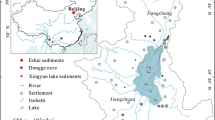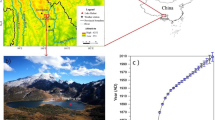Abstract
The analysis and interpretation of changes in mineral magnetic signatures from a long (ca. 8.2 m) sedimentary sequence recovered from Lake Qarun, Middle Egypt in 2003 spanning a timescale of approximately the last 2,000 years is reported. A suite of mass specific susceptibility and magnetic remanence measurements were made at irregular intervals downcore on 39 samples. These samples were selected on the basis of trends and abrupt changes in whole-core magnetic susceptibility measured using a Bartington® MS2E sensor and were analysed for low and high temperature loss on ignition and their particle size distribution. Trends in all mineral magnetic concentration parameters are remarkably similar and were initially used to divide the core into three magnetically distinct zones. The upper and lower sections of the core (0–119 cm and 445–822 cm depth) are characterised by low values for all magnetic concentration parameters. Between 153 and 380 cm depth, concentration parameters are considerably higher, although somewhat variable. The S ratio and percentage loss of remanence after 24 h (IRMloss) follow a different trend and are inversely related to each other. A low S ratio (<0.7) is associated with a loss of remanence of >4%. On the basis of these parameters, the core can be divided into four zones, and differences in magnetic mineralogy between these four zones were confirmed by measurement of IRM acquisition curves. The major difference between concentration parameters and ratios or percentage loss of IRM lies in the identification of an additional zone below 619 cm depth where the S ratio is high and IRMloss is low. There is little evidence to suggest that the magnetic signatures are controlled by particle size or by trends in organic matter and/or carbonate content. The signatures appear to be predominantly detrital and show little evidence of post-depositional alteration through dissolution or authigenic addition of bacterial magnetite or greigite. Analysis of Saharan dust deposition rates in Northern Egypt suggests that atmospheric fallout is likely to make only a very minor contribution (<1%) to sedimentation rates in Lake Qarun. The downcore trends therefore appear to reflect major changes in fluvial sediment sources over the ca. 2,000 year time period spanned by this ∼8 m core. Preliminary mineral magnetic characterisations of potential local sources suggest that these cannot account for the range of signatures recorded in the Qarun sediments and it is hypothesised that these sediments are derived from Nile river floods.





Similar content being viewed by others
References
Anderson NJ, Rippey B (1988) Diagenesis of magnetic minerals in the recent sediments of a eutrophic lake. Limnol Oceanogr 33:1476–1492
Bengtsson L, Enell M (1986) Chemical analysis. In: Berglund B (ed) Handbook of holocene palaeoecology and palaeohydrology. Wiley, Chichester, pp 423–451
Butzer KW (1976) Early hydraulic civilization in Egypt: a study in cultural ecology. University of Chicago Press, Chicago
Caton-Thompson G, Gardener EW (1934) The desert Faiyum, vol 2. Royal Anthropological Society, London, p 167
Chen FH, Wu RJ, Pompei D, Oldfield F (1995) Magnetic property and particle size variations in the late Pleistocene and Holocene parts of the Dadongling loess section near Xining, China. Quat Proc 4:27–40
Dearing JA (1999) Magnetic susceptibility. In: Walden J, Oldfield F, Smith J (eds) Environmental magnetism, a practical guide. Technical Guide No. 6: Quaternary Research Association, London, pp 35–62
El-Wakeel SK (1963) A study of the bottom deposits of Lake Qarun, Egypt: Part I. Mechanical analysis. Bulletin of the Faculty of Science, Alexandria University Press, Alexandria
Flower R J, Stickley C, Rose NL, Peglar S, Fathi AA, Appleby PG (2006) Environmental changes at the desert margin: an assessment of recent paleolimnological records in Lake Qarun, Middle Egypt. J Paleolimnol 35:1–24
Flower RJ, Keatings K, Peglar S, Tassie G, Abou Zeid R, and Hassan F (2008) Sedimentary records of environmental change in Lake Qarun, Egypt, with special reference to microfossils. In preparation
Foster IDL, Albon AJ, Bardell KM, Fletcher JL, Jardine TC, Mothers RJ, Pritchard MA, Turner SE (1991) High energy coastal sedimentary deposits: an evaluation of depositional processes in Southwest England. Earth Surf Process Landf 16:341-356
Foster IDL, Lees JA, Owens PN, Walling DE (1998) Mineral magnetic characterisation of sediment sources in the catchments of the Old Mill reservoir and Slapton Ley, South Devon, UK. Earth Surf Process Landf 23:685–703
Foster IDL, Lees JA, Jones AR, Chapman AC, Turner SE, Hodgkinson R (2002) The possible role of agricultural land drains in sediment delivery to a small reservoir, Worcestershire, UK: a multiparameter fingerprint study. Int Assoc Hydrol Sci Publ 276:433–442
Foster IDL, Boardman J, Keay-Bright J (2007) The contribution of sediment tracing to an investigation of the environmental history of two small catchments in the uplands of the Karoo, South Africa. Geomorphology 90:126–143
Gasse F (2000) Hydrological changes in the African tropics since the Last Glacial Maximum. Quat Sci Rev 19:189–211
Gasse F, Fontes JC, Plaziat JC, Carbonel P, Kaczmarska I, De Deckker P, Soulie-Marsche I, Callot Y, Dupeuble PA (1987) Biological remains, geochemistry and stable isotopes for the reconstruction of environmental and hydrological changes in the Holocene lakes from North Sahara. Palaeogeogr Palaeoclimatol Palaeoecol 60:1–46
Goudie AS, Middleton NJ (2001) Saharan dust storms: nature and consequences. Earth Sci Rev 56:179–204
Goudie AS, Middleton NJ (2006) Desert dust in the global system. Springer, Berlin
Hassan FA (1986) Holocene lakes and prehistoric settlements of the Western Faiyum, Egypt. J Archaeol Sci 13:486–501
Hassan FA (1996) Abrupt holocene climatic events in Africa. In: Pwiti G, Soper P (eds) Aspects of African archaeology. University of Zimbabwe, Harare, pp 83–89
Higgitt SR, Oldfield F, Appleby PG (1991) The record of land use change and soil erosion in the late Holocene sediments of the Petit Lac d’Annecy, eastern France. Holocene 1:14–28
Holzmann P, Gasse F, Dupont L, Salzmann L, Staubwasser M, Leuschner DC, Sirocko F (2005) Paleoenvironmental changes in the arid and sub arid belt (sahara-Sahel-Arabian Peninsular) from 150 ka to present. In: Battabee R, Gasse F, Stickely CE (eds) Past climate variability through Europe and Africa. Kluwer Academic, Dordrecht, pp 219–245
Juggins S (2003) C2 user guide. Software for ecological and paleoecological data analysis and visualization. University of Newcastle, Newcastle Upon Tyne, UK, 69 pp
Krom M.D, Stanley JD, Cliff RA, Woodward JC (2002) Nile river sediment fluctuations over the past 7000 yr and their key role in sapropel development. Geology 30:71–74
Maher BA (1988) Magnetic properties of some synthetic sub-micron magnetites. Geophys J R Astron Soc 94:83–96
Mehringer PJ, Patersen KL, Hassan FA (1979) A pollen record from Birket Qarun and the recent history of the Fayum, Egypt. Quat Res 11:238–256
Oldfield F (1994). Toward the discrimination of fine grained ferrimagnets by magnetic measurements in lake and near-shore marine sediments. J Geophys Res 99:9045–9050
Oldfield F (1999) The rock magnetic identification of magnetic mineral and grain size assemblages. In: Walden J, Oldfield F, Smith J (eds) Environmental magnetism, a practical guide. Technical Guide No. 6: Quaternary Research Association, London, pp 98–112
Oldfield F (2007) Sources of fine-grained magnetic minerals in sediments: a problem revisited. The Holocene 17:1265–1271
Oldfield F, Crowther J (2007). Establishing fire incidence in temperate soils using magnetic measurements. Palaeogeogr Palaeoclimateol Palaeoecol 249:362–369
Oldfield F, Frignani M, Yu L (1995) The magnetic properties of four sediment cores from the Adriatic: a preliminary report. In: Proceedings of Workshop 3, Projetto Stragetico Clima, Ambiente e Territorio nel Mezzogiorno, Potenza 1990, pp 681–701
Peglar SM, Birks HH, Birks HJ (2001) Terrestrial pollen record of recent land-use changes around nine North African lakes in the CASSARINA Project. Aquat Ecol 35:431–448
Reimer PJ, Baillie MGL, Bard E, Bayliss A, Beck WJ, Bertrand CJH, Blackwell PG, Buck CE, Burr GS, Cutler KB, Damon PE, Edwards RL, Fairbanks RG, Friedrich M, Guilderson TP, Hogg AG, Hughen KA, Kromer B, McCormac G, Manning S, Ramsey CB, Reimer RW, Remmele S, Southon JR, Stuiver M, Talamo S, Taylor FW, van der Plicht J, Weyhenmeyer CE (2004) INTCAL04 terrestrial radiocarbon age calibration, 0–26 Cal Kyr BP. Radiocarbon 46:1029–1058
Said R (1993) The river Nile: geology, hydrology and utilisation. Elsevier, Amsterdam
Snowball IF, Thompson R (1988) The occurrence of greigite in sediments from Loch Lomond. J Quat Sci 3:121–125
Soliman GF (1990) Observations on some physical conditions of lake Qarun. In: El-Raey M (ed) Regional symposium of environmental studies (UNARC). University of Alexandria, Alexandria, pp 588–601
Stanley DJ, Warne AG (1993) Nile Delta: recent geological evolution and human impact. Science 260:628–634
Talbot MR, Williams MAJ, Adamson DA (2000) Strontium isotope evidence for late Pleistocene reestablishment of an integrated Nile drainage network. Geology 28:343–346
Thompson R, Oldfield F (1986) Environmental magnetism. Allen & Unwin, London
Van der Post KD, Oldfield F, Hawarth EY, Crooks PRJ, Appleby PG (1997) A record of accelerated erosion in the recent sediments of Blelham Tarn in the English Lake District. J Paleolimnol 18:103–120
Vigliotti L, Capotondi L, Torii M (1999) Magnetic properties of sediments deposited in suboxic-anoxic environments: relationships with biological and geochemical proxie. In: Tarling DH, Turner P (eds) Palaeomagnetism and diagenesis in sediments. Geological Society of London Special Publications 151:71–83
Walden J (1999) Remanence measurements. In: Walden J, Oldfield F, Smith J (eds) Environmental magnetism, a practical guide. Technical Guide No. 6: Quaternary Research Association, London, pp 63–88
Walden J, Oldfield F, Smith J (eds) (1999) Environmental magnetism, a practical guide. Technical Guide No. 6: Quaternary Research Association, London
Wendorf F, Schild R (1976) Prehistory of the Nile Valley. Academic Press, New York
Woodward JC, Macklin MG, Welsby DA (2001) The Holocene fluvial sedimentary record and alluvial geoarchaeology in the Nile Valley of Northern Sudan. In: Maddy D, Macklin MG, Woodward JC (eds) River basin sediment systems: archives of environmental change. Balkema, Rotterdam, pp 327–355
Yu L, Oldfield F (1993) Quantitative sediment source ascription using magnetic measurements in a reservoir-catchment system near Nijar, S.E. Spain. Earth Surf Process Landf 18:441–454
Zheng H, Oldfield F, Yu L, Shaw J, An Z (1991) The magnetic properties of particle-sized samples from the Luo Chuan loess section: evidence for pedogenesis. Phys Earth Planet Inter 68:250–258
Acknowledgements
At Coventry, we thank Bob Hollyoak and Liz Turner for assistance with magnetic and particle size analysis and Stuart Gill for the diagrams. We also thank Bob Jude for doing the magnetic measurements in Liverpool. IDLF was in receipt of a Hugh Kelly Scholarship at Rhodes University, Grahamstown, South Africa during the final phases of manuscript production, which is also gratefully acknowledged. We acknowledge the Leverhulme Trust for funding that enabled collection of cores from Lake Qarun and routine sediment analyses by KK. Many persons kindly helped with core collection and handling including Richard Niederetter and Ramadan Abu Zeid.
Author information
Authors and Affiliations
Corresponding author
Rights and permissions
About this article
Cite this article
Foster, I.D.L., Oldfield, F., Flower, R.J. et al. Mineral magnetic signatures in a long core from Lake Qarun, Middle Egypt. J Paleolimnol 40, 835–849 (2008). https://doi.org/10.1007/s10933-008-9202-x
Received:
Accepted:
Published:
Issue Date:
DOI: https://doi.org/10.1007/s10933-008-9202-x




